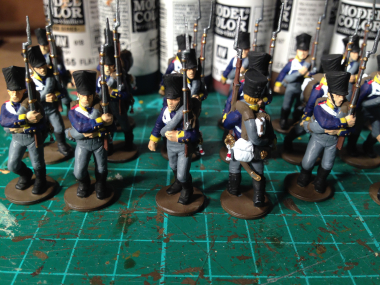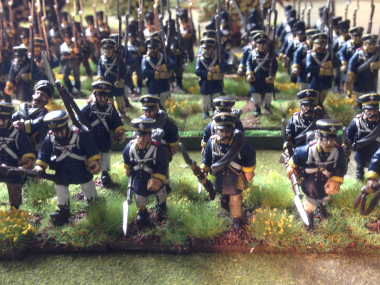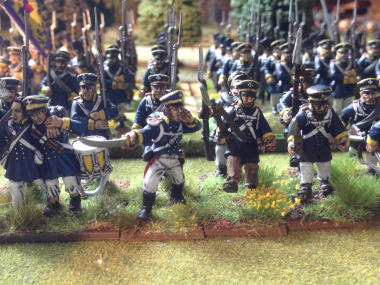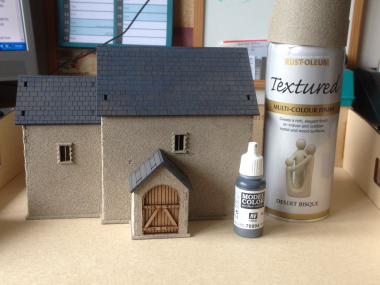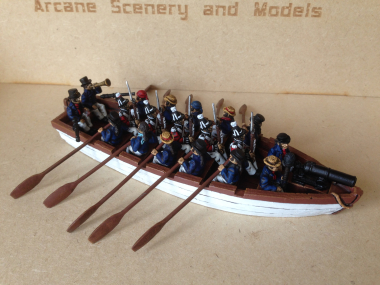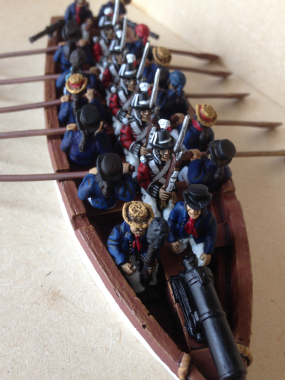 As we go into the Easter break it seemed appropriate to paint something vaguely egg shaped and as the Glyptodon had been sitting forlornly on the work bench in just an undercoat I decided his time had come!
As we go into the Easter break it seemed appropriate to paint something vaguely egg shaped and as the Glyptodon had been sitting forlornly on the work bench in just an undercoat I decided his time had come!
He is nicknamed the ‘kinder egg’ by the Arcane team due to his rotund shape but there’s plenty of detail in the casting that can be brought to life with a bit of dry brushing. I had hinted that I would use an airbrush to finish him but that will be a project for another day. I have put off buying an airbrush for now. Although I can see that it will be invaluable when painting Tanks and larger subjects like Mr Glypto, I am not quite in the right frame of mind to learn a whole new skill, particularly when I am still learning to paint with a brush! That said, I am of a mind to jump in to this mysterious world and who knows, I might just treat myself for Easter…..
Anyway, I digress, back to painting the Glyptodon. I had a quick look on Google for some inspiration and colour schemes and was pleasantly surprised at how many pictures there were! In the end, I went for a fairly safe option using a variety of browns in various combinations. To be specific, Vallejo light brown 70929, Flat brown 70984, Chocolate brown 70872 and to lighten them, Iraqi Sand 70819.
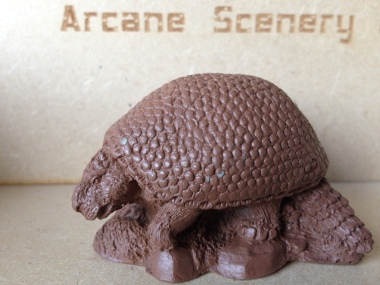
DeeZee Glyptodon
There was a slight problem when I started to paint. I had failed to follow my own advice and I had not washed the model before priming. The result was that the primer had started to flake off due to the release agent still on the casting. I confess, I was too lazy and impatient to start again, so I re primed the model with Model Mates Light grey primer. I have started to use this brand more often recently in favour of my usual Army Painter primer. It seems to be a much more effective primer and in this case, solved the flaking problem. However, lesson learnt, next time I will wash a resin model before painting! For the sake of 5 minutes, it will save time and heart ache in the long term!
So back to painting. The shell was done in the flat brown and then dry brushed with a couple of coats of the flat brown & light brown mixed. The fur was done with light brown, dry brushed with light brown and Iraqi sand. I picked the detail out around the shell with Iraqi sand and then I then gave it all a wash over using a dark tone ink. As with all these things, you have to fiddle around until you get the general effect that you are looking for and even now, I’m not sure whether to go back and add another lighter coat to the shell. The next task was to pick out his eyes, nose using black & claws using ivory and to paint some of the detail on the base. I then mounted him onto a renedra base and blended the model to the base using Vallejo Desert sand paste. If you haven’t tried these pastes from Vallejo, give them a go – they are superb for basing and once dry you can paint straight over the paste as there is sufficient texture. I like to add sand to give even more detail.

Glyptodon painted – working on the base
I finished off the base by adding some detail to the rocks, painted the tree stump and painted the grass and of course the sand. This was all done using virtually the same pallet of Chocolate Brown and Iraqi Sand, with plenty of dry brushing of lighter combinations of these colours – the final dry brush was done with some white added in. To finish off, I added some Static grass and of course a few clumps of flowers! I’m reasonably happy with the result for now – as I said, I may add a final lighter coat to his shell but he’s off to the cabinet.

The finished Glyptodon!
I often find that it’s difficult to know when a model is finished so sometimes it’s best to put it to one side and then have a look after a week or so. If I’m still not happy then I might try a bit of retouching. This was the case with the baby mammoth. I just wasn’t happy with the way he looked, so he has sat on the paint table whilst I decided what to do. In the end it was a case of cutting down his tusks – they were too big even for a baby Mammoth – and giving him another even lighter dry brush to add detail & adding some ink to bring out the shadows. I also gave him a snowy base with some frosted tufts. I’m still not entirely happy but he is looking better for now. Perhaps I’ll have a go at another one – I have a diorama in mind that involves a nasty Sabre tooth……

DeeZee Mammoth Calf

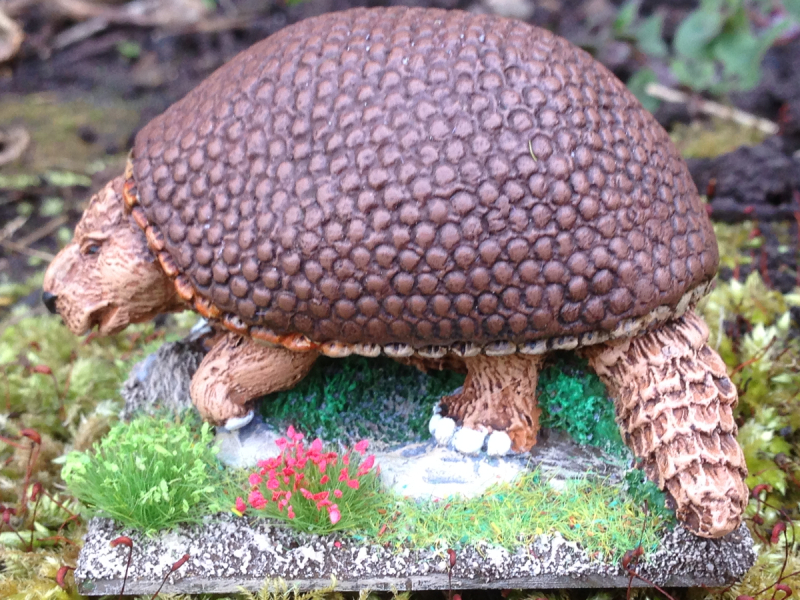


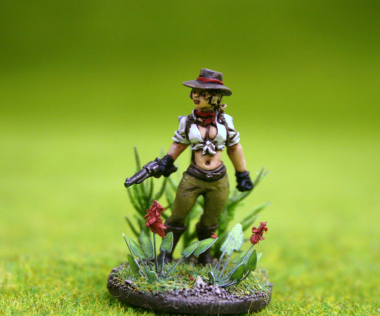
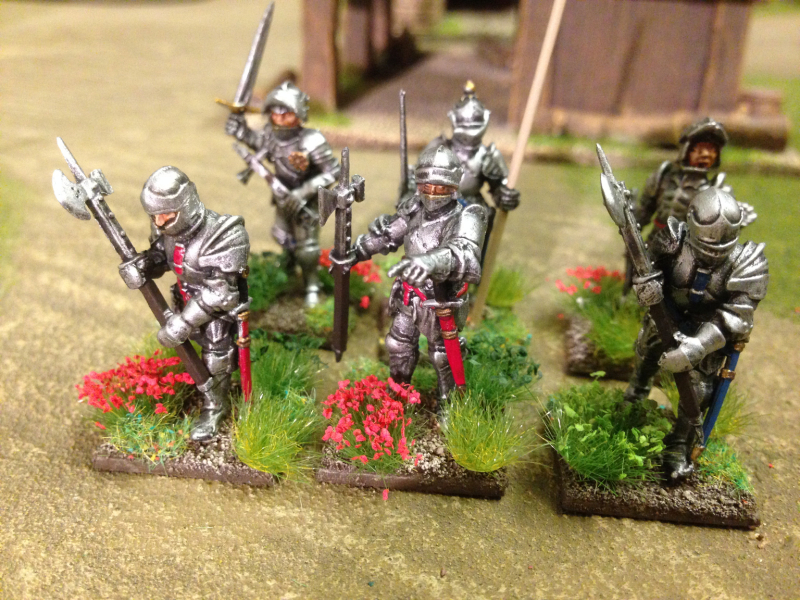
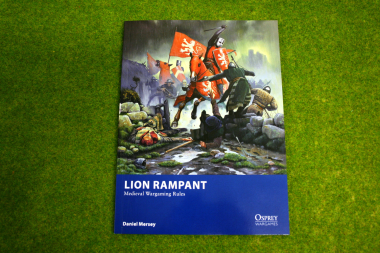 I mentioned in my blog earlier that I had signed up for the Wargames Illustrated Magazine’s Lion Rampant day, to be held on 31st January 2015. Although it seems some way off, I thought that I better start putting my retinue together and of course practicing the game. As I am somewhat focused on collecting English Armies (and their Allies!), I thought that I would start with a typical English Warband. In the LR rules this breaks down to: a unit of 6 foot men at arms; a unit of 12 ‘expert’ foot sergeants and two units of 12 ‘expert’ Bowmen; a total of 42 figures to assemble and paint.
I mentioned in my blog earlier that I had signed up for the Wargames Illustrated Magazine’s Lion Rampant day, to be held on 31st January 2015. Although it seems some way off, I thought that I better start putting my retinue together and of course practicing the game. As I am somewhat focused on collecting English Armies (and their Allies!), I thought that I would start with a typical English Warband. In the LR rules this breaks down to: a unit of 6 foot men at arms; a unit of 12 ‘expert’ foot sergeants and two units of 12 ‘expert’ Bowmen; a total of 42 figures to assemble and paint.
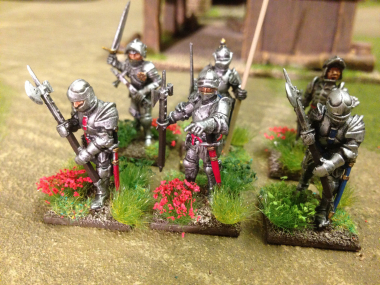
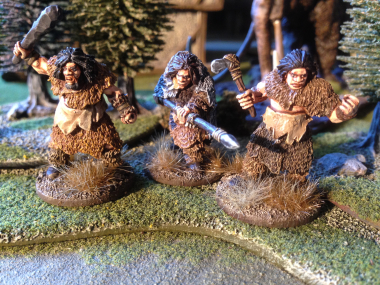
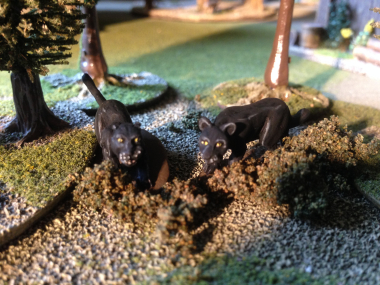 The next project was the Jaguars. I’m not sure that I am happy with the finished result. Painting and highlighting black is a devilish business! I’ve tried using blue rather than grey or white and in the end it was a mixture of both but I haven’t got the effect that I was looking for. I also used white to paint on some whiskers & for the teeth but it all looks a bit stark. the standard of photography isn’t too good either!The yellow eyes have just about worked. I think that when they are properly based, with plenty off jungle cover they may look OK. So that’s it for this week. Next up, back to Hanoverians – the officers this time.
The next project was the Jaguars. I’m not sure that I am happy with the finished result. Painting and highlighting black is a devilish business! I’ve tried using blue rather than grey or white and in the end it was a mixture of both but I haven’t got the effect that I was looking for. I also used white to paint on some whiskers & for the teeth but it all looks a bit stark. the standard of photography isn’t too good either!The yellow eyes have just about worked. I think that when they are properly based, with plenty off jungle cover they may look OK. So that’s it for this week. Next up, back to Hanoverians – the officers this time. A strange mix of subjects on my workbench at the moment! I’ve just about finished painting 18 rank & file Hanoverian Landwehr. As you can see from the picture, they’re all based and ready for the table. There are of course 6 figures missing – the officers, ensigns & sergeants. They are undercoated and ready to paint, so they should keep me busy for the next few painting sessions. I will then have a nice unit of 24 figures representing the Munden Landwehr battalion. As far as finishing the figures went, once I had painted them with Army painter Strong tone, I gave them 24 hours to dry and then sprayed them with Army painter Anti shine. I tend to use a light coat and if the figures are still a bit shiny in places then I use vallejo matt varnish, just brushed on, to finish off.
A strange mix of subjects on my workbench at the moment! I’ve just about finished painting 18 rank & file Hanoverian Landwehr. As you can see from the picture, they’re all based and ready for the table. There are of course 6 figures missing – the officers, ensigns & sergeants. They are undercoated and ready to paint, so they should keep me busy for the next few painting sessions. I will then have a nice unit of 24 figures representing the Munden Landwehr battalion. As far as finishing the figures went, once I had painted them with Army painter Strong tone, I gave them 24 hours to dry and then sprayed them with Army painter Anti shine. I tend to use a light coat and if the figures are still a bit shiny in places then I use vallejo matt varnish, just brushed on, to finish off.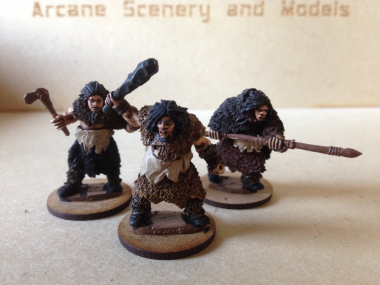 The other project that has leap-frogged up the painting queue is pack two of the Lucid Eye Neanderthals. Arcane Scenery are now stocking the Lucid Eye Range and of course the Neanderthals go really well with some of the Ice Age DeeZee miniatures that we produce. The Mammoths, Cave Bears & Smilodons for starters! So I’m working on getting a little band of Neanderthals ready for a Hunting party. One is just about finished, except the basing, the other two are just awaiting the fur pelts to be highlighted & the detail picked out. The techinique that I have used for these is slightly different from my usual style. Rather than using ‘dip’ to shade, I am shading and highlighting using inks, dry brushing and mixing lighter & lighter shades of the base colours. It’s a bit more time consuming for me but gives a nice result, particularly when the figures are so well sculpted. Here’s the progress so far. I’ll spend a bit more time in my next blog detailing the colours used.
The other project that has leap-frogged up the painting queue is pack two of the Lucid Eye Neanderthals. Arcane Scenery are now stocking the Lucid Eye Range and of course the Neanderthals go really well with some of the Ice Age DeeZee miniatures that we produce. The Mammoths, Cave Bears & Smilodons for starters! So I’m working on getting a little band of Neanderthals ready for a Hunting party. One is just about finished, except the basing, the other two are just awaiting the fur pelts to be highlighted & the detail picked out. The techinique that I have used for these is slightly different from my usual style. Rather than using ‘dip’ to shade, I am shading and highlighting using inks, dry brushing and mixing lighter & lighter shades of the base colours. It’s a bit more time consuming for me but gives a nice result, particularly when the figures are so well sculpted. Here’s the progress so far. I’ll spend a bit more time in my next blog detailing the colours used.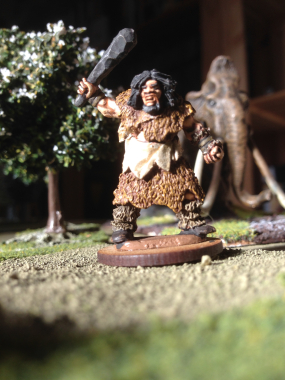
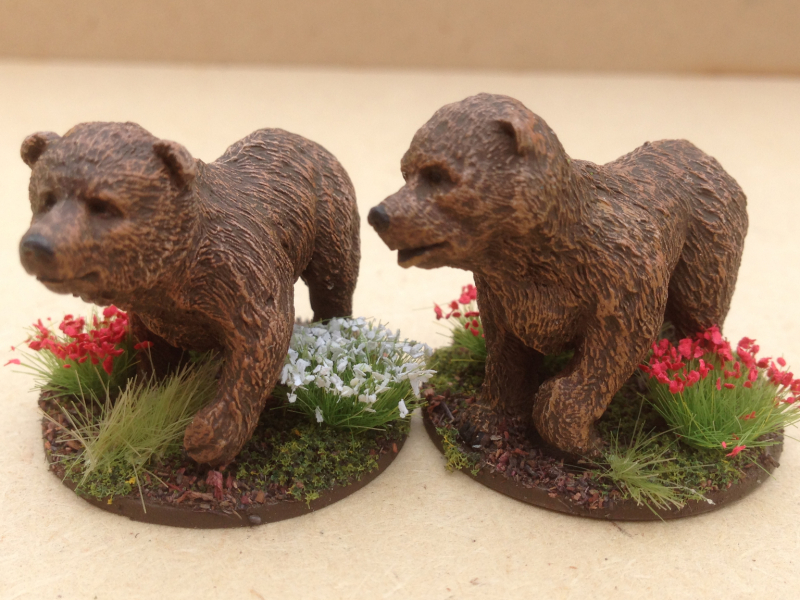

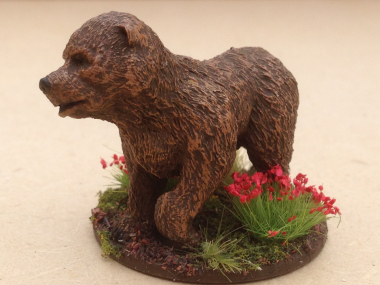

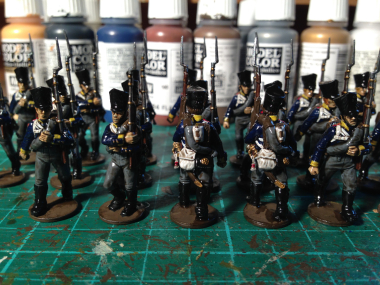

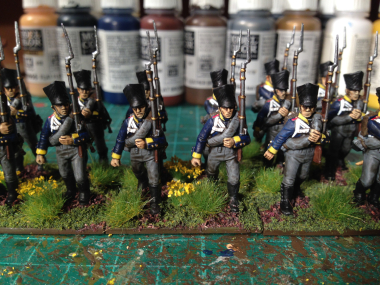
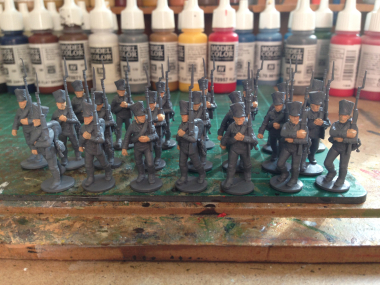


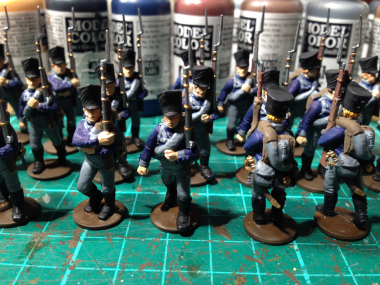 , brass for the bands on the barrel, stock, sword handle, scabbard end & badge on the cartridge box. Next up, I carefully paint in the webbing, Bread sack and detail on the back pack, as well as the sword knot. You could use Vallejo white 951 but I prefer to use the off white 820. At this stage the figures are nearly fully painted. So far, it has taken me about 8 hours of painting, or to be more realistic 4 evening sessions of two hours. Any longer & my back seizes up!
, brass for the bands on the barrel, stock, sword handle, scabbard end & badge on the cartridge box. Next up, I carefully paint in the webbing, Bread sack and detail on the back pack, as well as the sword knot. You could use Vallejo white 951 but I prefer to use the off white 820. At this stage the figures are nearly fully painted. So far, it has taken me about 8 hours of painting, or to be more realistic 4 evening sessions of two hours. Any longer & my back seizes up!